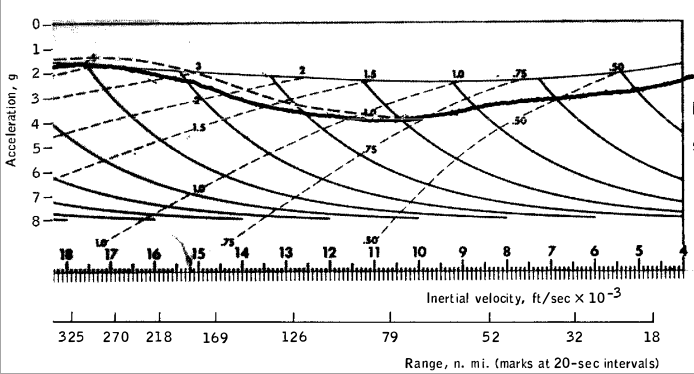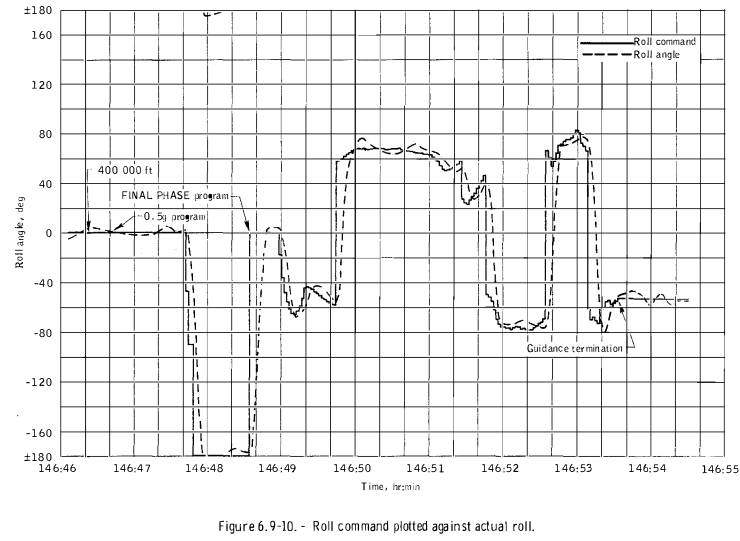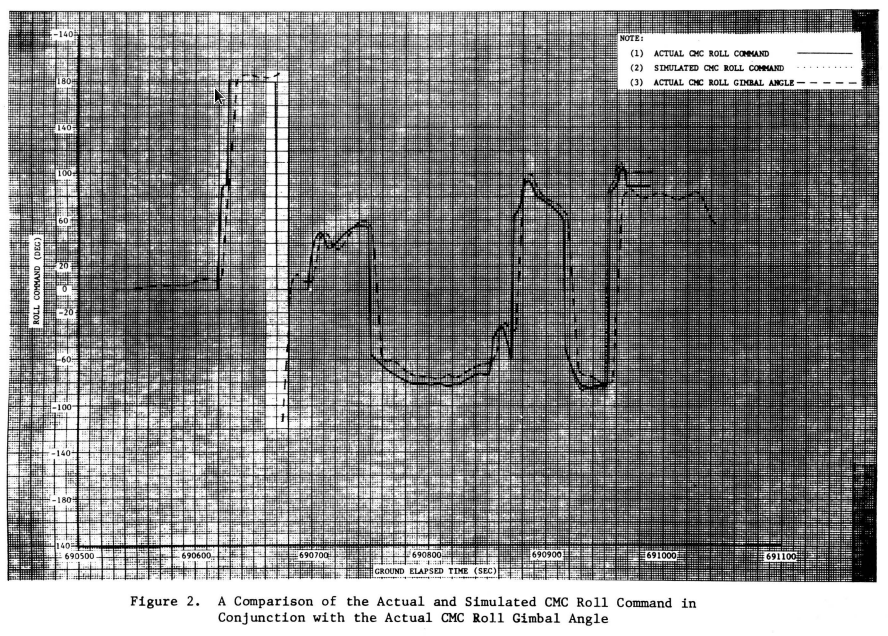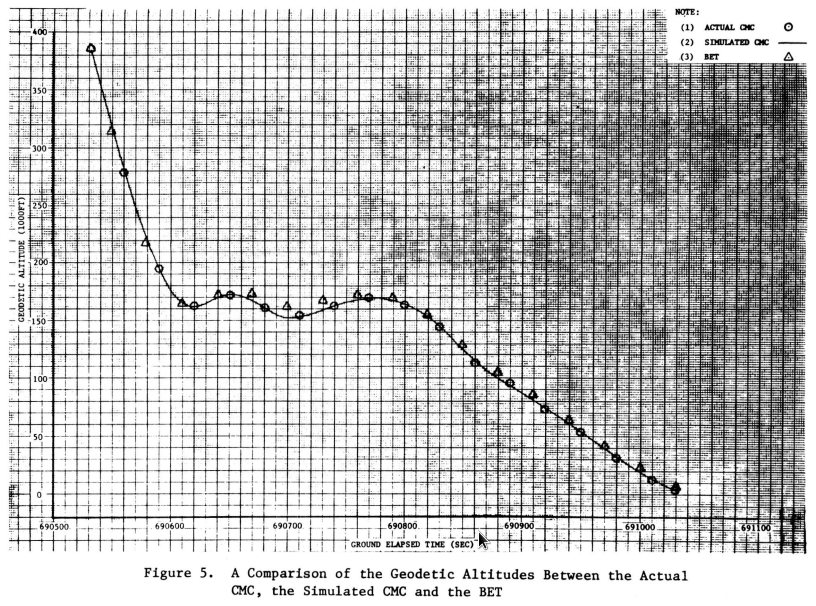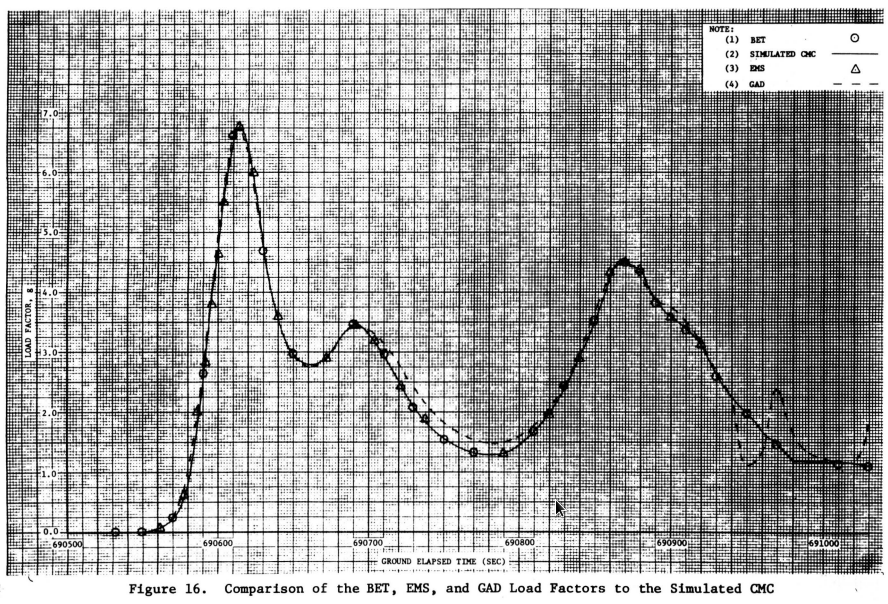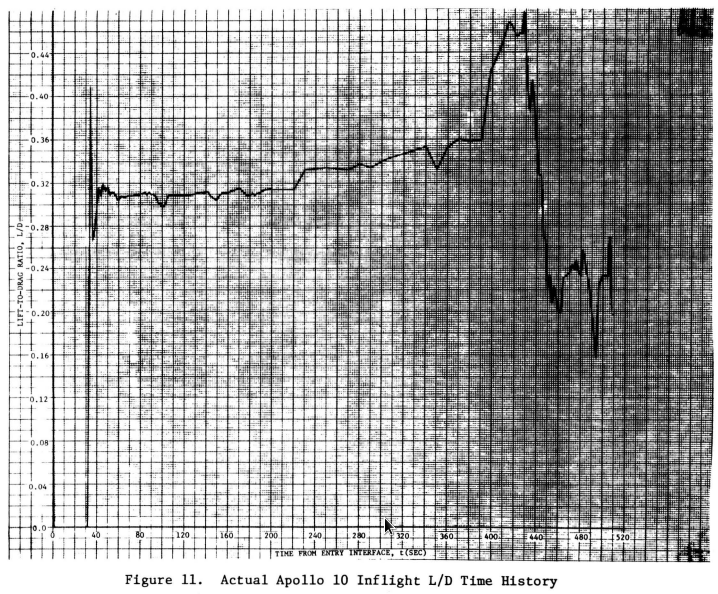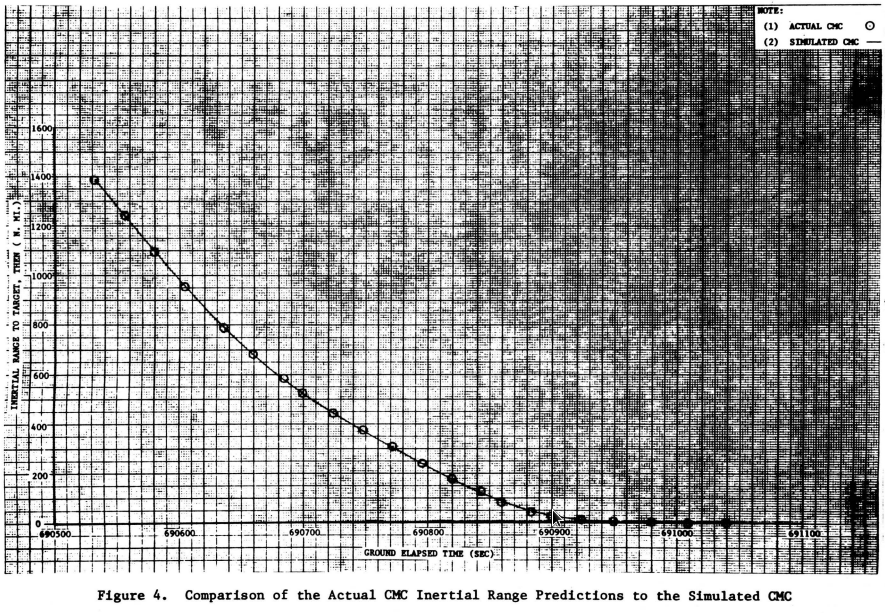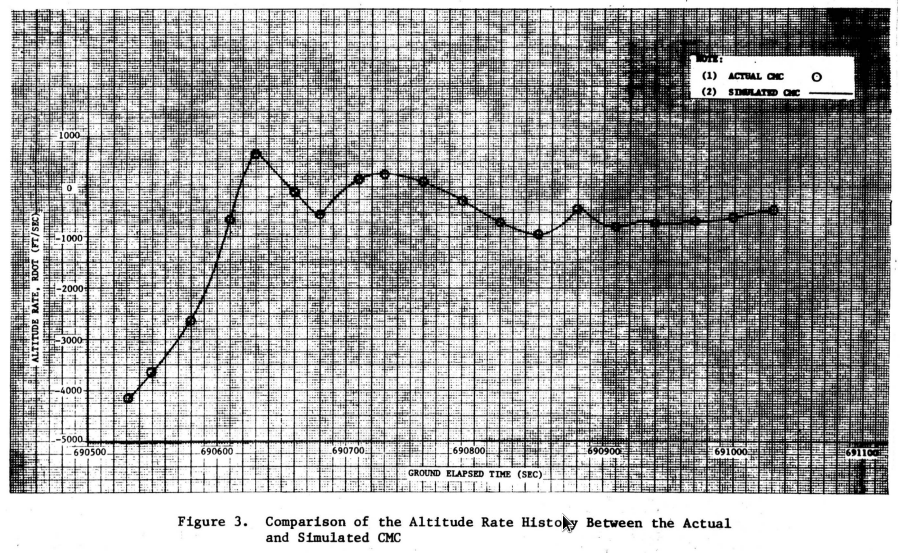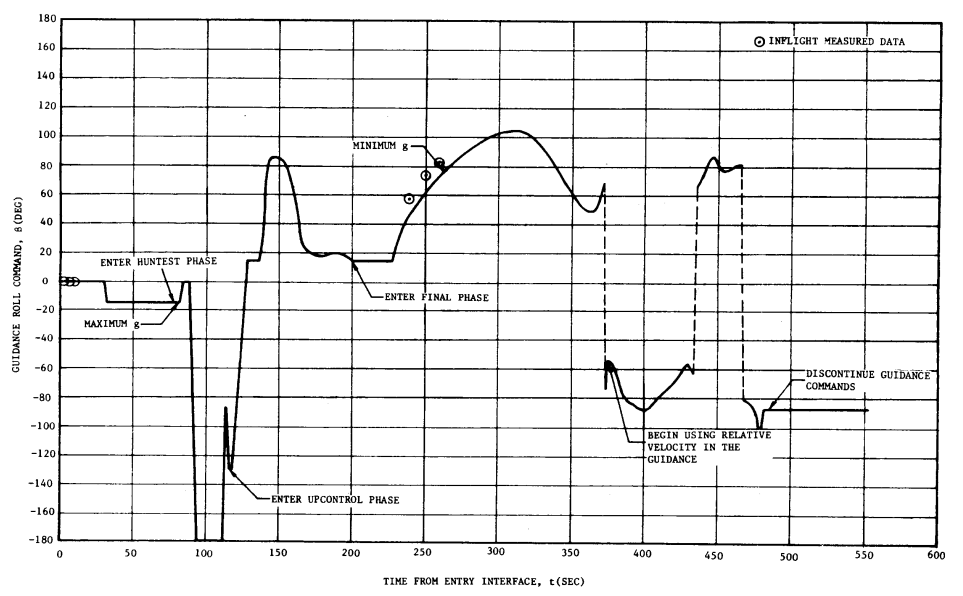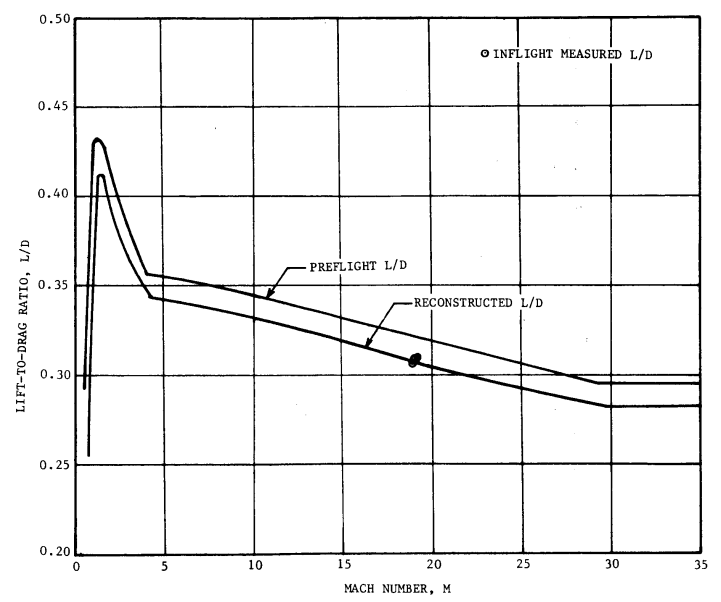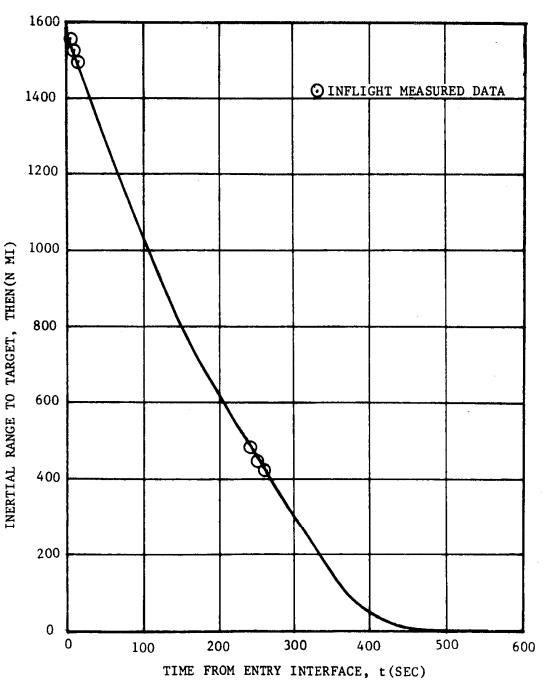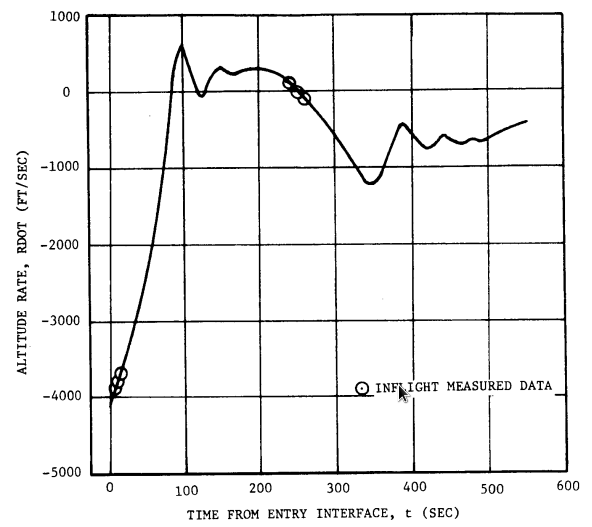|
Size: 6394
Comment:
|
Size: 7315
Comment:
|
| Deletions are marked like this. | Additions are marked like this. |
| Line 6: | Line 6: |
| Useful graphs for Apollo 8, 10, and 11. I cannot find useful entry information after Apollo 11, so these three sets are hopefully representative of the other six lunar missions. | Useful graphs for Apollo 8, 10, and 11. I cannot find useful entry information after Apollo 11, so these three sets are hopefully representative of the other six lunar missions. |
| Line 8: | Line 8: |
| The "entry scroll" is a paper graph that was preloaded into the [[ http://nassp.sourceforge.net/wiki/Entry_Monitoring_System | Entry Monitoring System]], and scrolled past a little window in the control panel between the left and center seats. If the computer failed, the command module pilot adjusted the roll and lift of the command module to follow the graph. There were two graphs, skip and no skip; if weather over the primary recovery site was bad, the computer (or the CMP manually) would select the "skip" graph and extend reentry by a few hundred kilometers. Apollo 11 skipped to avoid a thunderstorm, the other missions did landed at the primary. | The command module had roll and attitude thrusters, which were used to indirectly control the trajectory. The center-of-mass of the command module was offset toward's the astronaut's feet. That edge of the CM would lead into the airstream; the capsule could be rotated with the roll thrusters so that the lift vector (directed towards the nose) vectored the spacecraft left, right, up, or down. The lift-to-drag ratio for the CM was approximately 0.3, so if the entry drag was near maximum at 6 gees, the lift vector would be about 2 gees, pointed whichever way was necessary to adjust the trajectory. Coming in above orbital velocity, the lift vector would be pointed earthward to keep the CM at the right altitude; below "Vcirc" the lift vector was pointed up to maintain altitude (and thus density and drag force). The "entry scroll" is a paper graph that was preloaded into the [[ http://nassp.sourceforge.net/wiki/Entry_Monitoring_System | Entry Monitoring System]], and scrolled past a little window in the control panel between the left and center seats. If the computer failed, the command module pilot adjusted the roll and lift of the command module to follow the graph. There were two graphs, skip and no skip; if weather over the primary recovery site was bad, the computer (or the CMP manually) would select the "skip" graph and extend reentry by a few hundred kilometers. Apollo 11 skipped to avoid a thunderstorm, the other missions did not skip, and landed at the primary recovery site. Apollo 16 was the '''highest gee reentry.''' ''I wonder why???'' |
Apollo Entry
From Apollo mission reports here
Apollo 7 and 9 were earth orbit, slower reentry. Apollo 8 and 10 through 17 were lunar missions with high speed reentry of the command module. Apollo 11,12, and 14-17 were landing missions.
Useful graphs for Apollo 8, 10, and 11. I cannot find useful entry information after Apollo 11, so these three sets are hopefully representative of the other six lunar missions.
The command module had roll and attitude thrusters, which were used to indirectly control the trajectory. The center-of-mass of the command module was offset toward's the astronaut's feet. That edge of the CM would lead into the airstream; the capsule could be rotated with the roll thrusters so that the lift vector (directed towards the nose) vectored the spacecraft left, right, up, or down. The lift-to-drag ratio for the CM was approximately 0.3, so if the entry drag was near maximum at 6 gees, the lift vector would be about 2 gees, pointed whichever way was necessary to adjust the trajectory. Coming in above orbital velocity, the lift vector would be pointed earthward to keep the CM at the right altitude; below "Vcirc" the lift vector was pointed up to maintain altitude (and thus density and drag force).
The "entry scroll" is a paper graph that was preloaded into the Entry Monitoring System, and scrolled past a little window in the control panel between the left and center seats. If the computer failed, the command module pilot adjusted the roll and lift of the command module to follow the graph. There were two graphs, skip and no skip; if weather over the primary recovery site was bad, the computer (or the CMP manually) would select the "skip" graph and extend reentry by a few hundred kilometers. Apollo 11 skipped to avoid a thunderstorm, the other missions did not skip, and landed at the primary recovery site.
Apollo 16 was the highest gee reentry. I wonder why???
Click pictures for enlargements
Apollo 8
- page 5-10, 53/252 TABLE 5-V . - ENTRY TRAJECTORY PARAMETERS
- Entry at 400 kft (122 km) at 146:46:12.8
- velocity 36 221 ft/s ( 11 040 m/s)
- flight path angle -6.50 degrees, ( 0.114 slope )
- maximum velocity 36 303 ( 11 065 m/s )
- maximum acceleration 6.84 gees
- page 6-67 to 6-69 entry graphs
Entry Monitor System Scroll, Gees vs Velocity
Roll vs Mission Elapsed Time
Apollo 10
- page 6-13, 54/323 TABLE 6-VI I . - ENTRY TRAJECTORY PARAMETERS
- Entry at 400 kft (122 km) at 191:48:54.5
- velocity 36 314 ft/sec (11 068 m/s)
- flight-path angle -6.54 degrees ( slope 0.115 )
- maximum velocity 36 397 ft/s ( 11 094 m/s)
- maximum acceleration 6.78 gees
Entry Monitor System Scroll, Gees vs velocity
Roll and Altitude vs Ground Elapsed Time
Gees and Lift/Drag vs Ground Elapsed Time
Range and Vertical Velocity vs Ground Elapsed Time
Apollo 11
- page 7-12 120/359 TABLE 7-VI I . - ENTRY TRAJECTORY PARAMETERS
- Entry at 400 kft (122 km) at 195:03:05.7
- velocity 36 194.4 ft/sec (11 032 m/s)
- flight-path angle -6.48 degrees ( slope 0.114 )
- maximum velocity 36 227.4 ft/s ( 11 042 m/s)
- maximum acceleration 6.51 gees
- 1st maximum load factor 6.73g 31,810ft/s
- 1st minimum load factor 0.48g 20,500ft/s
- 2nd maximum load factor 6.00g 12,390ft/s
Table III
EI time |
Load g |
V f/s |
range n mi |
° Bank |
Rdot f/s |
0:00 |
0.000 |
36190 |
1593 |
|
|
0:28 |
0.049 |
36276 |
1418 |
|
|
0:30 |
|
36277 |
|
0.0 |
-3186 |
1:18 |
|
|
|
|
-666 |
1:30 |
|
30176 |
|
54.43 |
211 |
1:56 |
1.057 |
22091 |
|
-86.68 |
|
Entry Monitor System Scroll, Gees vs Velocity
Roll and Altitude vs Time from Entry Interface
Gees vs Time from Entry Interface and Lift/Drag vs Mach Number (velocity)
Range and Vertical Velocity vs Time from Entry Interface
Velocity vs Time from Entry Interface
Apollo 12
- page 5-14 96/310 TABLE 5-IX . - ENTRY TRAJECTORY PARAMETERS
- Entry at 400 kft (122 km) at 244:22:19.1
- velocity 36 116 ft/sec (11 008 m/s)
- flight-path angle -6.48 degrees ( slope 0.108 )
Apollo 13 Mission report page 9-17, two brief paragraphs about entry and landing (useless)
Apollo 14 Mission report page 5-28, two brief paragraphs about entry and landing (useless)
Apollo 15 Mission report page 114, two brief paragraphs about entry and landing (useless)
Apollo 16 Mission report page 9-56, "entry deceleration exceeded 7 gees" (semi-useless)
Apollo 17 Mission report page 190, no trajectory data (useless)


